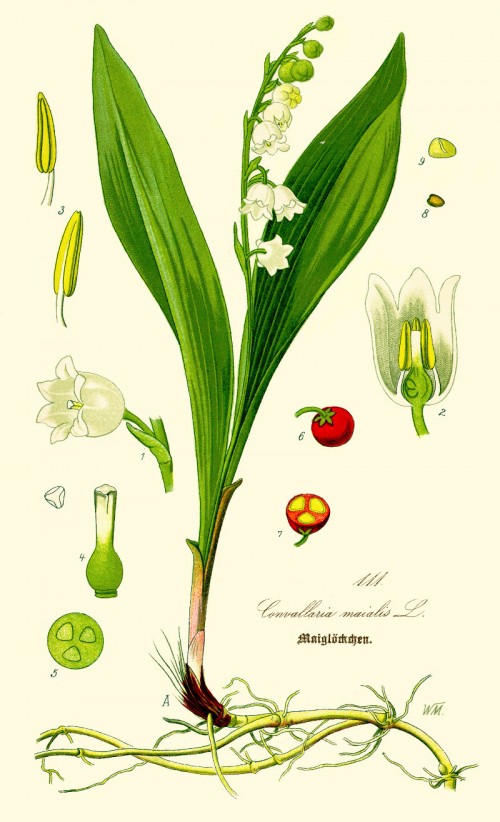Dies ist eine alte Version des Dokuments!
Convallaria majalis L. - Liliaceae - lily of the valley, Maiglöckchen
Herb with creeping rhizom, 0.10-0.20m, native to Europe; leaves mostly 2, elliptic-lanceolate; flowers bell-shaped, white, highly fragrant, pendent on a one-sided raceme; fruit a red berry.
„C. majalis is a native of Europe, where it largely avoids the Mediterranean and Atlantic margins. An eastern variety, C. majalis var. manschurica occurs in Japan and parts of eastern Asia. A limited native population of C. majalis var. montana occurs in Eastern USA . There is, however, some debate as to the native status of the American variety.“ http://en.wikipedia.org/wiki/Lily_of_the_valley
The fragrant volatiles of Convallaria majalis flowers were enriched by dynamic and vacuum headspace sampling. The products of the vacuum process displayed a more typical odor, maybe due the higher content of farnesol (2-3%) and 2,3-dihydrofarnesol (2%). Main volatiles of the flowers (vacuum) were benzyl alcohol (27-44%) and geraniol (10-17%), together with (E)-ocimene (traces), citronellyl acetate (0.5-3%), (Z)-3-hexenyl acetate (1%), benzyl acetate (1%), phenylacetonitrile (2-4%), phenylacetaldoxime (1-2%), and cinnamic alcohol (3-7%).
[Surburg et al., Volatile compounds from Flowers, in: Teranishi, R.;Buttery, R. G.;Sugisawa, H. Bioactive volatile compounds from plants. (Book) 1993, 169-186]
„The odorants could be divided into floral-rosy-citrusy notes: citronellol (9.6%), geraniol (8.4%), nerol (1.3%), citronellyl acetate (1.1%), geranyl acetate (3.3%), geranial + benzyl acetate (0.96%), neral (0.02%), benzyl alcohol (35%), phenethyl alcohol (0.78%), phenylacetonitrile (3.0%), farnesol (1.9%) and 2,3-dihydrofarnesol (0.88 %), green-grassy notes: (Z)-3-hexen-1-ol (11%), (Z)-3-hexenyl acetate (7.8%), (Z)-3-hexenal (trace) and (E)-2-hexenal (0.18%), green pea and galbanum-like notes: 2-isopropyl-3-methoxypyrazine (trace) and 2-isobutyl-3-methoxypyrazine (trace), fatty, waxy, aldehydic notes: octanal (0.15%), nonanal (0.1 %), decanal (0.07%) and fruity, raspberry notes: β-ionone (trace).“
http://www.bojensen.net/EssentialOilsEng/EssentialOils17/EssentialOils17.htm
[New data on trace components with sensory relevance in flower scents, Brunke, E.J., Rittler, F., Schmaus, G., Dragoco Rep., 1, 1996, 5-21]
The standardised (effect correponding to 0.2% convallatoxin) powder of dried aboveground parts of C.majalis (Convallaria herba) is used against mild cardiac insuffiency. „Convallatoxin is similar to other cardiac glycosides. It inhibits Na+,K+ ATPase and indirectly increases intracellular Ca+ concentration.This strengthens the contraction of the heart muscle… The herb is very toxic and must only be administered under the supervision of a qualified practioner.“
[Medicinal Plants of the World. Ben-Erik Van Wyk and Michael Wink, Pretoria 2004, 112]

Thomé,O.W., Flora von Deutschland Österreich und der Schweiz, Tafeln, vol.1, t.111 (1885)
http://plantgenera.org/species.php?id_species=270522
Convallaria majalis
© Rolf Marschner (2009),
www.botanische-spaziergaenge.at
